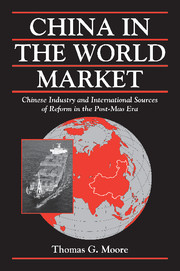Book contents
- Frontmatter
- Contents
- List of Figures
- List of Abbreviations
- Preface
- 1 China as a Latecomer in World Industrial Markets
- 2 The Outside World as an Impetus for Change in China
- 3 Tailor to the World: China's Emergence as a Global Power in Textiles
- 4 Beating the System with Industrial Restructuring: China's Response to the Multifiber Arrangement (MFA)
- 5 China Looms Large: Reform and Rationalization in the Textile Industry
- 6 Industrial Change in the Shadow of the MFA: The Role of Top-Level Strategy, Mid-Level Intervention, and Low-Level Demand in China's Textile Industry
- 7 Chinese Shipbuilding: The Modest Origins of an Emerging Industrial Giant
- 8 Dangerous Currents: Navigating Boom and Bust Cycles in International Shipbuilding
- 9 Chinese Shipbuilding and Global Surplus Capacity: Making a Virtue out of Necessity
- 10 Market-Oriented Solutions for Industrial Adjustment: The Changing Pattern of State Intervention in Chinese Shipbuilding
- 11 Who Did What to Whom?: Making Sense of the Reform Process in China's Shipbuilding Industry
- 12 External Shocks, State Capacity, and National Responses for Economic Adjustment: Explaining Industrial Change in China
- 13 China in the Contemporary International Political Economy
- Appendix Contours of the Research Effort
- Bibliography
- Index
6 - Industrial Change in the Shadow of the MFA: The Role of Top-Level Strategy, Mid-Level Intervention, and Low-Level Demand in China's Textile Industry
Published online by Cambridge University Press: 07 August 2009
- Frontmatter
- Contents
- List of Figures
- List of Abbreviations
- Preface
- 1 China as a Latecomer in World Industrial Markets
- 2 The Outside World as an Impetus for Change in China
- 3 Tailor to the World: China's Emergence as a Global Power in Textiles
- 4 Beating the System with Industrial Restructuring: China's Response to the Multifiber Arrangement (MFA)
- 5 China Looms Large: Reform and Rationalization in the Textile Industry
- 6 Industrial Change in the Shadow of the MFA: The Role of Top-Level Strategy, Mid-Level Intervention, and Low-Level Demand in China's Textile Industry
- 7 Chinese Shipbuilding: The Modest Origins of an Emerging Industrial Giant
- 8 Dangerous Currents: Navigating Boom and Bust Cycles in International Shipbuilding
- 9 Chinese Shipbuilding and Global Surplus Capacity: Making a Virtue out of Necessity
- 10 Market-Oriented Solutions for Industrial Adjustment: The Changing Pattern of State Intervention in Chinese Shipbuilding
- 11 Who Did What to Whom?: Making Sense of the Reform Process in China's Shipbuilding Industry
- 12 External Shocks, State Capacity, and National Responses for Economic Adjustment: Explaining Industrial Change in China
- 13 China in the Contemporary International Political Economy
- Appendix Contours of the Research Effort
- Bibliography
- Index
Summary
EVEN if we accept that the international environment was a powerful influence in impelling certain changes in the textile industry, we must still account for the response within China. Did the reforms and other policy changes in the industry mainly reflect strategy made by the top leadership to cope with life under the MFA? Or were they fundamentally the result of bureaucratic intervention by MTI/CNTC, CHINATEX, or MOFERT/MOFTEC at either the national or provincial level? Or, finally, did the main impulse for change come from below as enterprises (and other local actors) reacted to changing market conditions at home and abroad? In other words, are the changes that occurred in the textile industry best conceptualized as the outcome of top-level strategy, mid-level intervention, or low-level demand? This question will serve as the primary focus of this chapter. Before addressing this important topic, however, we must first examine more closely the evolving role of various bureaucratic players involved in China's textile industry. Only by surveying this “alphabet soup” of institutions, a subject not comprehensively explored in previous chapters, is a full assessment of their role in the system possible, especially vis-à-vis higher- and lower-level actors.
RESHAPING THE ORGANIZATIONAL LANDSCAPE OF THE CHINESE TEXTILE INDUSTRY
As with all eras of change, there were both winners and losers in China's textile industry during the 1980s and early 1990s. Of the three leading bureaucratic players, MOFERT gained the most strength.
- Type
- Chapter
- Information
- China in the World MarketChinese Industry and International Sources of Reform in the Post-Mao Era, pp. 144 - 162Publisher: Cambridge University PressPrint publication year: 2002



